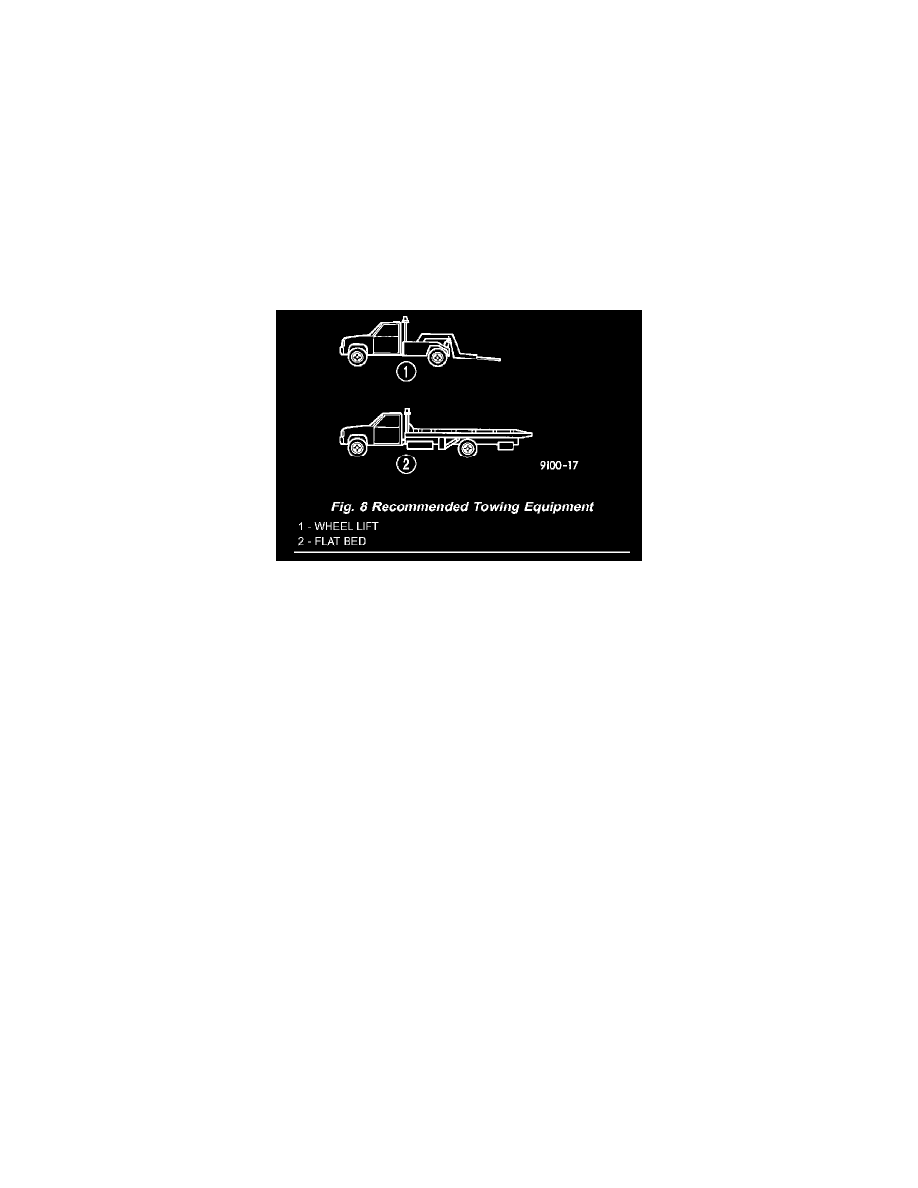Sebring LXI Sedan V6-2.7L VIN R (2002)

Towing Information: Service and Repair
STANDARD PROCEDURE - TOWING
WARNINGS AND PRECAUTIONS
WARNING: DO NOT ALLOW TOWING ATTACHMENT DEVICES TO CONTACT THE FUEL TANK OR LINES, FUEL LEAK CAN
RESULT. DO NOT LIFT OR TOW VEHICLE BY FRONT OR REAR BUMPER, OR BUMPER ENERGY ABSORBER UNITS. DO NOT
VENTURE UNDER A LIFTED VEHICLE IF NOT SUPPORTED PROPERLY ON SAFETY STANDS. DO NOT ALLOW PASSENGERS
TO RIDE IN A TOWED VEHICLE. USE A SAFETY CHAIN THAT IS INDEPENDENT FROM THE TOWING ATTACHMENT
DEVICE.
CAUTION: Do not damage brake lines, exhaust system, shock absorbers, sway bars, or any other under vehicle components when attaching towing
device to vehicle. Do not attach towing device to front or rear suspension components. Do not secure vehicle to towing device by the use of front or
rear suspension or steering components. Remove or secure loose or protruding objects from a damaged vehicle before towing. Refer to state and local
rules and regulations before towing a vehicle. Do not allow weight of towed vehicle to bear on lower fascia, air dams, or spoilers.
Fig.8 Recommended Towing Equipment
RECOMMENDED TOWING EQUIPMENT
To avoid damage to bumper fascia and air dams use of a flat bed towing device or wheel lift (Fig. 8) is recommended. When using a wheel lift towing
device, be sure the unlifted end of disabled vehicle has at least 100 mm (4 in.) ground clearance. If minimum ground clearance cannot be reached, use
a towing dolly. If a flat bed device is used, the approach angle should not exceed 15 degrees.
GROUND CLEARANCE
CAUTION: If vehicle is towed with wheels removed, install lug nuts to retain brake drums or rotors.
A towed vehicle should be raised until the lifted wheels are a minimum 100 mm (4 in.) from the ground. Be sure there is at least 100 mm (4 in.)
clearance between the tail pipe and the ground. If necessary, remove the wheels from the lifted end of the vehicle and lower the vehicle closer to the
ground, to increase the ground clearance at the rear of the vehicle. Install lug nuts on wheel attaching studs to retain brake drums or rotors.
LOCKED VEHICLE TOWING
When a locked vehicle must be towed with the front wheels on the ground, use a towing dolly or flat bed hauler.
FLAT TOWING WITH TOW BAR
-
Three speed automatic transaxle vehicles can be flat towed at speeds not to exceed 40 km/h (25 mph) for not more than 25 km (15 miles). The
steering column must be unlocked and gear selector in neutral.
-
Five speed manual transaxle vehicles can be flat towed at any legal highway speed for extended distances. The gear selector must be in the neutral
position.
FLAT BED TOWING TIE DOWNS
CAUTION: Do not tie vehicle down by attaching chains or cables to suspension components or engine mounts, damage to vehicle can result.
JR vehicles can be tied to a flat bed device using the reinforced loops located under the front and rear bumpers on the drivers side of the vehicle.
There are also four reinforced elongated holes for T or R hooks located on the bottom of the front frame rail torque boxes behind the front wheels and
forward of the rear wheels inboard of the rocker panel weld seam.
TOWING - FRONT WHEEL LIFT
DaimlerChrysler Corporation recommends that a vehicle be towed with the front end lifted, whenever possible. A 90 cm (36 in.) length of 4x4 wood
beam can be placed between the wheel lift device and the bottom of the fascia to prevent damage to vehicle during the lifting operation. The beam can
